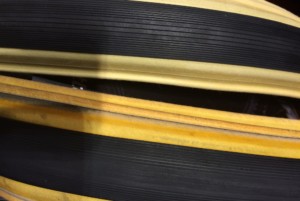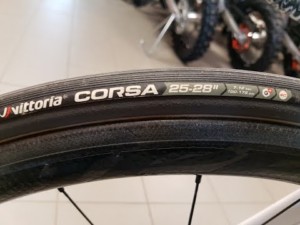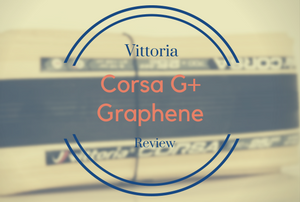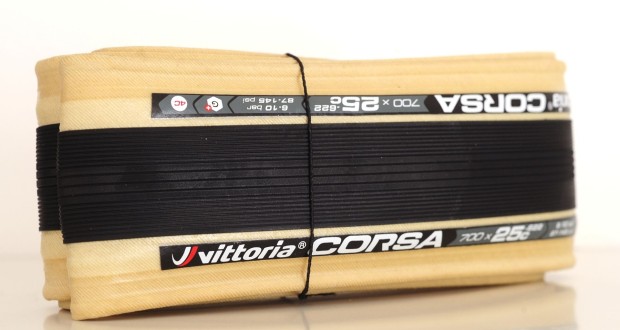Vittoria has a reputation for producing some of the best tires on the market. Their Corsa, with its corespun cotton casing and super gummy rubber is a favorite race day tire. It's too fragile for training, though. The sticky tread can wear in a matter of a thousand miles, meaning you may have to replace your tires 4 or 5 times per season!
That can get expensive, so Vittoria made a few changes. The revised tread compound and added durability led to the creation of the G+ series of tires. Click through the jump to read my Vittoria Corsa G+ review and find out if this is the perfect training tire for you.
Vittoria Corsa G+ Review
As with all of my reviews, I've run these tires through the ringer. I've got around 1800 miles of smooth tarmac, dirt roads, busted up asphalt and post winter salt under them. I'll include my opinions on Vittoria's technology, tire mounting, actual size, performance and durability below.
 Corsa G+ Tire Technology
Corsa G+ Tire Technology
Vittoria based the Corsa G+ series of tires on the old classic Corsa design. That means it's a 320 TPI (thread count) cotton base slathered with rubber tread compound. However, in this case, it's more than just a single tread compound. It's actually 4 separate compounds that are mated together via a process called 4C ISOtech. That process allows Vittoria to strategically place each compound in the tire casing offering the most all around performance. Vittoria is able to place different compounds on the center of the tread and the shoulders, which gives the Corsa a fast rolling center and a predictable, confidence inspiring cornering profile.
There's also an additional impregnation of Kevlar in the compound to provide flat resistance. Combine that with the core spun cotton tread and you've got a tire that has excellent puncture resistance to go along with great cornering and straight line speed.
But where does the “G+” designation come into play? Vittoria includes a helping of Graphene in the rubber compound. What's Graphene? Graphene is a kind of carbon compound that has a very high strength to weight ratio. It adds almost no additional weight to the tire and increases flat resistance and, more importantly, longevity significantly.
Corsa G+ mounting
The Vittoria Corsa G+ is based on the old Corsa carcass, so you'd expect an open tubular kind of design. You'd be right on the money with that assertion. As with the previous generation of Corsa tires, the Corsa G+ was a pleasure to mount. Sure, you can use a pair of tire levers to wedge the bead over the rim, but honestly, you don't need anything more than your hands and some solid technique.
I started by locating the label over the valve stem hole and then getting one bead in the rim bed. Stick the tube in and start stuffing the other bead inside the rim bed, starting from the valve. I did find that “pulling” the tire away from the valve stem helped create just enough extra room to slip the remaining bead over the rim. Grab your floor pump, inflate to around 85 PSI and you're good to go.
One thing I'd like to note, I found that the beads took a couple of tries to seat all the way around. This could be due to the rims or it could be the tires themselves. I've had the same issue with other tires, so I'm inclined to believe it's the rims. Just keep an eye out so you don't end up with an uneven tire and a bumpy ride after you mount them.
Corsa G+ actual size on the rim
I mounted the 25mm version of the Corsa G+ on a pair of Rol C35 carbon clincher. These wheels measure around 17.5mm inner width, allowing for a nice, round tire profile. When I mounted them up, I was very surprised about the actual width of the Corsa G+s. They were actually 25mm wide! Imagine that. I've become so used to tire manufacturers claiming a size for their tires and then finding them to be either significantly larger or significantly smaller than advertised.
That discrepancy in advertised size can be down to rim width and a couple other factors. Generally, it's not a big deal to find a tire is wider or smaller than advertised. But sometimes frame clearances are pretty tight and a tire that is wider than advertised could be absolutely incompatible with today's aero framesets.
 Corsa G+ performance
Corsa G+ performance
Since the G+ is based on the open tubular Corsa, you'd expect it to perform well. It actually performs superbly when all is said and done. The 320 TPI core spun case makes for a tire that's smooth riding and sticky in dry weather. I've seen it described as “supple and grippy” and I tend to agree. The circumferential grooving seems to help channel water away, giving it excellent performance in wet conditions.
According to some literature from Vittoria, the Corsa G+ is actually a faster tire because of all that differing tread compound. Over a 50km course at 50KPH, the G+ was tested at 32 seconds faster than the non-graphene version of the Corsa. Testing was performed by a Finnish company called Wheel Energy. I don't have access to the actual test data, but I can say that the Corsa G+ feels faster than the old Corsa did. It also feels a lot faster than the Zipp Tangente, but that may be down to the massive difference in size between the two. The Tangente is around 21mm, the Corsa G+ is a solid 25mm, and it's been shown that wider tires tend to be faster in a number of situations.
I have to say the weight of these things is a little more than I had expected. The pairs that I tested averaged 254 and 261 grams per tire respectively. They are advertised at 240g/tire, which is a little hefty compared to the old Corsa at 220 grams/tire. It's not a deal-breaker, but it's still an extra 2 ounces of weight that you're trying to get moving.
Corsa G+ durability
I'm pretty hard on tires. Let's get that out of the way right now. I tend to find ways to ruin tires that most sane people would not believe. Pinch flat a tubular in 2 places? Yep, I've done that. Tear a hole in a sidewall? Yep, done that. Ripped a tread off the bead? Yes, I did that on a mountain bike. The point is, if you want to torture test tires, I'm the guy to do it for you.
Keeping that in mind, I'm going to tell you that I've put around 1800 miles on the Vittoria Corsa G+, and I'm really happy with how they've held up. I was always a fan of the Corsa open tubular design, but they were really relegated to racing tires only (and even then, I rarely raced on clinchers, preferring either Corsa tubs or Zipp Tangente tubs, which were based on the Corsa design.) Running a Corsa as a training tire for the season would probably lighten your wallet by around $500 over the course of the season. You would only expect to get around 1000 to 1500 miles out of them before they were shot.
In this case, whether it's the Kevlar reinforcement or the graphene impregnated tread the Corsa G+ wears a LOT better than the old Corsa design. After 1800 miles of rough northeast roads, dirt, gravel and wet conditions the biggest wear is actually along the sidewalls. And that is this tire's biggest weakness, in my opinion. These are quite a bit more durable than the Michelin Pro Race 4 that I tested a while back. They're not quite as durable as the Vittoria Rubino Pros that I've run for years as training tires, but those really are one of the toughest wearing tires out there today.
Vittoria Corsa G+ Final Impressions
No Vittoria Corsa G+ review would be complete without telling you if I would recommend these tires.
Without hesitation, I'd say yes. They are a fantastic evolution of the Open Corsa design with some additional longevity built into them. That durability was sorely needed, too. If you're looking to get the absolutely best ride feel out of these tires, combine them with some Vittoria latex tubes and you'll get a buttery smooth road feel. In fact, the Corsa G+ and latex tube combination are probably as close to tubular ride feel as possible without switching to tubular tires.
Overall, despite the weak sidewalls and the high MSRP, I'd say these tires are one of the best options on the market today for a durable, smooth riding all purpose tire.

